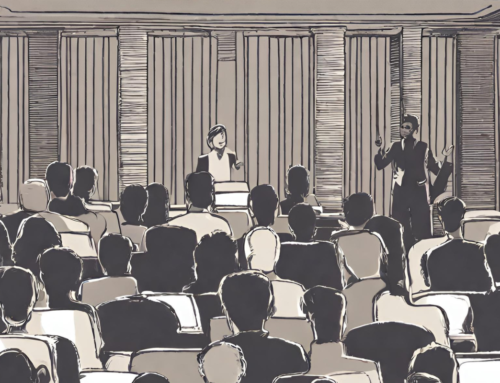All speakers wish to connect with their audiences. What is the most powerful way to do that? Every communication is two conversations – content and body language. Body language is where connection happens.
So how do you connect with an audience through body language? Not surprisingly, perhaps, connection is first and foremost about closeness.
We all unconsciously measure the distance between ourselves and everyone else for obvious reasons of self-protection first and interest second. Here’s how it works. Twelve feet or more is public space, the coolest connection between people. Between twelve feet and four feet is social space, a little warmer than public space but still cool.
Four feet to a foot and a half is personal space, and now things are beginning to get interesting for us. A foot and a half to zero is intimate space, and we willingly let only people we trust highly or are very fond of in this space.
These spaces vary a bit from culture to culture; Mediterranean and Asian cultures tend to shrink the distances, and Western cultures expand them. But all of us have the four zones.
Try them out yourself. Walk down the street in a small town, and note when you make eye contact with approaching strangers and when they make eye contact with you. You will find that it is always astonishingly close to twelve feet. I assume this is because at that distance, we can still do something about a danger that presents itself; any closer and we might not have time to react.
Now try the move into the personal zone with someone. You’ll see that you keep your eyes, at minimum, on each other, and usually you’ll change your entire physical orientation when someone moves into your personal space. Interest and energy increase. Your heart rate increases slightly. It’s personal, and you’re connected.
If you move into someone’s intimate space, a new level of tension arises, unless of course you are already intimate with that person—a spouse, a very close friend, a parent, or a child. If you’re not intimate, the closeness will feel uncomfortable for both of you, and typically one or the other of the two people will try to draw back into safer personal space.
I’ve demonstrated this phenomenon many times to audiences I’ve lectured to about communication, and it usually gets a laugh because of the discomfort everyone feels. Once I was talking about the zones with a small group of executives, and I moved into the intimate space of one of the women in the room as I was talking. She responded by giving me a solid right hook to the chest!
She apologized afterward, but of course she was simply responding with instinctive appropriateness because I had violated her intimate zone. Once we all recovered, this incident made the point very well to everyone in the room about how important it is to understand the four zones and how deeply people are conditioned to maintain them. No doubt they developed in prehistoric times as a matter of life and death.
We’ve all seen drill sergeants in movies who put their face an inch or two from the hapless inductee and say in stentorian tones that ‘he’s a maggot’. The point here is that the inductee is not allowed to maintain his intimate space; he’s being broken down in order to be built up again as a Marine, for example. Partly it’s just good theater, but it also violates a real sense of self-protection and so is destabilizing and humiliating for the inductee. These zones are powerful reminders that we are animals who carefully guard our physical and psychic integrity and protect ourselves unconsciously at all times.
So how do you use these zones to increase the connectedness with the person or persons you’re trying to communicate with? Here’s the essential point: Everything significant in communication between people happens in personal space or intimate space.
Vote for SXSW! Please click on the following link and vote for the SXSW panels on communications:








Hi Nick,
Interesting analysis. Clearly, speaking to a large audience really challenges the issue of connectedness. Looking forward to your tips on that!
Kathy
Great blog suggestion — look for it next week! Thanks, Nick
HI,
Great points. Will try the eye contact exercise while walking down the street and let you know.
Cheers
Darren Fleming
Australia’s Public Speaking COach
I agree totally. The first few minutes in any speech are crucial and to keep them glued to what you’re saying.